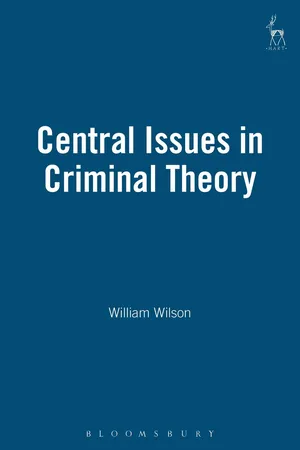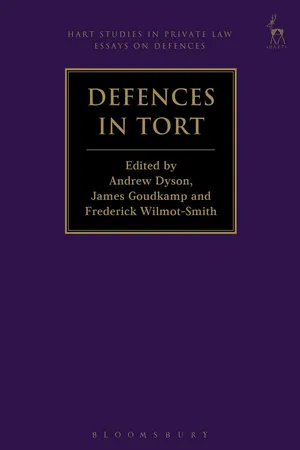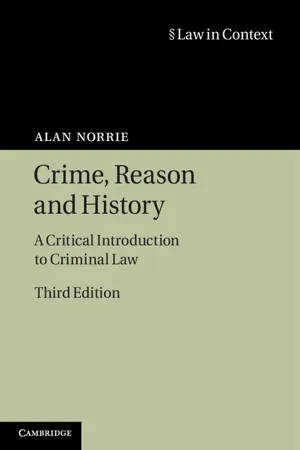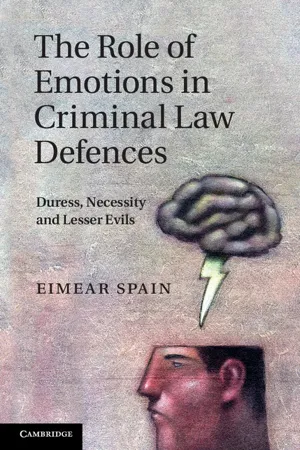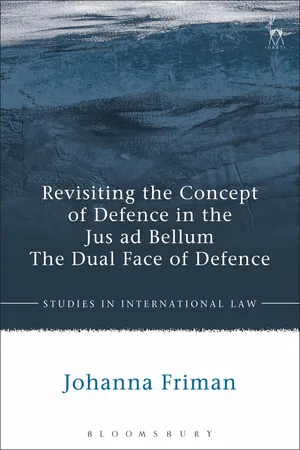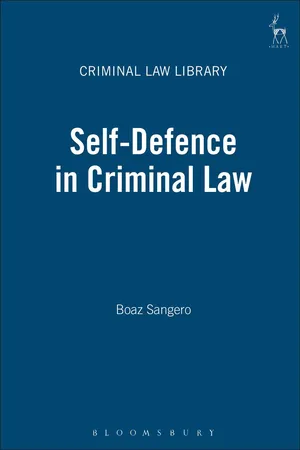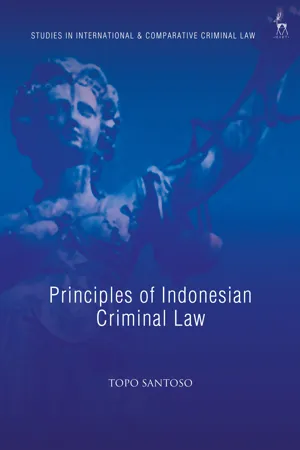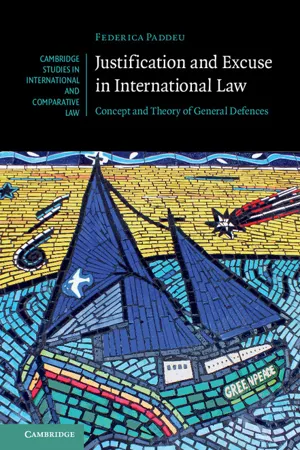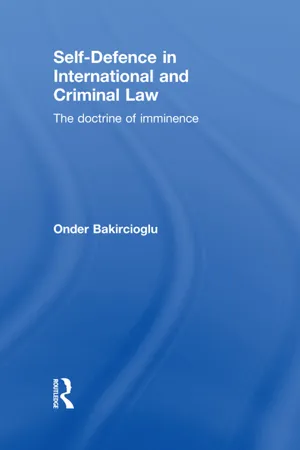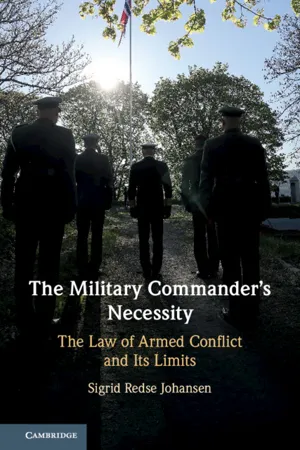Law
Defence of necessity
Defence of necessity is a legal principle that allows a person to justify their actions if they were necessary to prevent a greater harm. It is based on the idea that in certain situations, breaking the law is justified in order to avoid a more serious consequence. This defence is typically used in cases where there was no reasonable alternative to the action taken.
Written by Perlego with AI-assistance
Related key terms
1 of 5
12 Key excerpts on "Defence of necessity"
- eBook - PDF
- William Wilson(Author)
- 2002(Publication Date)
- Hart Publishing(Publisher)
In necessity the cost of not acting in a way which may involve wrongdoing is a yet greater evil or harm, rendering it morally impera-tive to act in that fashion. In self defence legal permission is granted to a person to take necessary and proportionate steps to resist, repel or ward off an unjust threat posed by another person. 38 Specifying these agendas allows us some insight into the potential scope of each defence, and also its limits, since they dictate the doctri-nal differences bounded by the overall template. So, the supposed absence of an immediacy requirement in necessity is no doctrinal aber-ration. This is most apparent in the specialised context of medicine, where doctors acting in their patients’ best interests are required to minister to their patients’ clinical interests on a pre-emptive as well as Criminal Defences: Setting Limits to Justifications 303 37 See J Dressler, ‘Exegesis of the Law of Duress: Justifying the Excuse and Searching for its Proper Limits’ (1989) 62 S Cal L Rev 1331. 38 S Uniacke, Permissible Killing , 177–89; J Horder, ‘Self Defence, Necessity and Duress’ [1998] Can J of Law and Juris 143. reactive basis. It reflects the broad moral agenda of necessity which is to underwrite the desirability that individuals do what they can to pre-vent harm befalling others. Again while proportionality of response is central to all three defences the level of response permitted varies with the moral agenda of the respective defences. Necessity requires that action taken must be unambiguously for the best if society’s ex ante normative guidance is to be overridden and if individual rights are to be protected from the routine claims of social utility. Duress requires the sacrifice demanded of the victim (typically death or serious injury) be of such a high order that expecting obedience would be futile before the rights of innocent people can excusably be compromised. - eBook - PDF
- Andrew Dyson, James Goudkamp, Frederick Wilmot-Smith, Andrew Dyson, James Goudkamp, Frederick Wilmot-Smith(Authors)
- 2015(Publication Date)
- Hart Publishing(Publisher)
12 1.1.2 Defence of the Person The defence of ‘self-defence’ 13 is distinct from necessity, because self-defence is engaged where the defendant is protecting himself from the claimant, who is the source of the danger and so responsible for it, whereas necessity need not be pro-voked by any actual or threatened danger by the claimant. 14 The nature of this distinction is illustrated by Lewis v Arnold , 15 where a group of men unlawfully entered a private box in a theatre when there was no room for them in the pit. The proprietor, who removed them from the theatre using reasonable force, was held to have acted in self-defence (or perhaps more appropriately private defence, because he was protecting a property right rather than his personal autonomy), since the threat to the defendant came directly from the claimants’ actions in trespassing in the private box and this justified the defendant’s use of reasonable force. It is unclear, however, where the dividing line between self-defence and necessity should be drawn. In particular, which defence is engaged where the threat to the defendant’s right derives from the claimant’s property rather than from his actions? For example, in Cresswell v Sirl 16 the defendant shot the claimant’s dog, which had 9 [2004] EWCA Civ 892; [2005] Env LR 6. The Court traced the rule back to Farquharson v Farquharson , Deans of Court of Session, William Maxwell Morison (1811) vol XXIX–XXX, 12779. 10 A further limitation is that the rule will not apply where an established watercourse is diverted to protect the defendant’s land: R v Trafford (1831) 1 B & Ad 874; 109 ER 1011. 11 Arscott v The Coal Authority (n 9) [37] (Laws LJ). See, eg, Hurdman v NE Ry Co (1878) 3 CPD 168 (CA); Whalley v Lancashire and Yorkshire Railway (n 7). 12 See further Section 3.2. 13 In a strict sense, self-defence involves defence of the defendant from attack by the claimant. - eBook - PDF
Crime, Reason and History
A Critical Introduction to Criminal Law
- Alan Norrie(Author)
- 2014(Publication Date)
- Cambridge University Press(Publisher)
The discussion in this chapter reflects the changing patterns of thinking in the law, before considering some of the broader issues around the conceptual structure of defences. 3 (i) Necessity’s ambiguous history A brief historical survey reveals that the necessity defence has always been regarded with ambivalence by lawyers. In the sixteenth century, it was argued that a distinction could be drawn between a breach of the letter and of the spirit of the law. The former breach could ‘give way to some acts and things done against the words of the same laws . . . where the words of them are broken to avoid greater inconveniences, or through necessity, or by compulsion’ (Reniger v. Fogossa (1552)). In 1630, Bacon identified situations of hunger, of drowning persons fighting for a plank and of escapes from a burning jail as ones where no crime was committed on account of necessity (Glazebrook, 1972, 110–11). Hale, however (1736, 1, 54), with whom Blackstone agreed, stated that theft ‘being under necessity for want of victuals or clothes’ was still a felony (see generally Glazebrook, 1972; Fletcher, 1978, 822–3). The political issues behind the defence, which echoed through the courtroom again in the 1971 civil case of London Borough of Southwark v. Williams (1971) (see below, p 215), were to the fore in Hale’s account. He observed that a Defence of necessity would render private property insecure, and that no true necessity situation could emerge because of the Poor Laws. At the same time, he rebuked those who claimed that there was a necessity defence for thereby advising ‘apprentices and servants to rob their masters’. Green’s comments on Blackstone, quoted at the head of the chapter, are also germane. 3 Discussions of the duress case of Howe (J Smith, 1987; K Smith, 1989; Ashworth, 1999) suggest that the judges have moved more to a discourse of justification than excuse in this area, but this is only partly borne out by a reading of the case. - eBook - PDF
The Role of Emotions in Criminal Law Defences
Duress, Necessity and Lesser Evils
- Eimear Spain(Author)
- 2011(Publication Date)
- Cambridge University Press(Publisher)
217 Similar sentiments were expressed by Wilson J in Perka et al. v. The Queen: 218 [w]here the Defence of necessity is invoked as a justification the issue is simply whether the accused was right in pursuing the course of behaviour giving rise to the charge. Thus . . . the accused must show that he operated under a conflicting legal duty which made his seemingly wrong- ful act right. But such justification must be premised on a right or duty recognized by law. This excludes conduct attempted to be justified on the ground of an ethical duty internal to the conscience of the accused as well as conduct sought to be justified on the basis of a perceived maximization of social utility resulting from it. Rather, the conduct must stem from the accused’s duty to satisfy his legal obligations and to respect the principle of the universality of rights. 219 The Court curtailed the defence in that jurisdiction due to fears that recognising a right to break the letter of the law under necessity to assist a stranger would create a duty to rescue. They suggested that: rescue scenarios often represent the mirror image of necessity scenarios; to acknowledge necessity as a justification premised on the discharge of the conflicting duty to rescue a stranger could, without much stretch of the imagination, be turned around so as to enable a potential rescuee to assert a right to be rescued by any stranger. 220 On this basis the Court restricted the defence to those who could assert a legal duty. As an excusatory defence based on the concession to human frailty, the arguments discussed in the preceding passage on the defence of duress are pertinent. However, the scheme proposed in this book involves the creation of a defence of duress based on an evaluation of the emotions experienced by the defendant and a separate lesser evils necessity defence. The distinction between these defences lies not in the 216 [2001] Fam 147. 217 Ibid., at 255. 218 (1984) 13 DLR (4th) 1. 219 Ibid., at 37. - eBook - PDF
The Sanctity of Life and the Criminal Law
The Legacy of Glanville Williams
- Dennis J. Baker, Jeremy Horder(Authors)
- 2013(Publication Date)
- Cambridge University Press(Publisher)
12 The failure of the Defence of necessity as a mechanism of legal change on assisted dying in the common law world penney lewis I Introduction In his 1953 Current Legal Problems lecture on necessity, Williams described the Defence of necessity in now familiar utilitarian terms as involving: a choice of the lesser evil. It requires a judgment of value, an adjudication between competing ‘goods’ and a sacrifice of one to the other. The language of necessity disguises the selection of values that is really involved. 1 Williams saw the defence as ‘an implied exception to particular rules of law’ which would be available to defendants charged with any criminal offence, even a statutory offence which does not mention necessity as a defence. 2 II A necessity defence for voluntary active euthanasia Although that early lecture did not mention euthanasia as an example of the suitable use of the defence, Williams advocated its use at some length in The Sanctity of Life and the Criminal Law. The bulk of his analysis concerned cases involving the administration of pain relief which may also hasten death, but Williams began with the classic case of voluntary active euthanasia: 1 Glanville Williams, ‘Defence of necessity’, Current Legal Problems, 6 (1953), 216–35, at p. 224. 2 Williams, ‘Defence of necessity’, at p. 224. 274 If the doctor gives the patient a fatal injection with the intention of killing him, and the patient dies in consequence, the doctor is a common murderer because it is his hand that has caused the death. Neither the consent of the patient, nor the extremity of his suffering, nor the immi- nence of death by natural causes, nor all these factors taken together is a defence. This, at any rate, is always assumed by lawyers, though there is no case in which the argument that the concurrence of all three factors may present a defence has been actually advanced and decided. - eBook - PDF
Revisiting the Concept of Defence in the Jus ad Bellum
The Dual Face of Defence
- Johanna Friman(Author)
- 2017(Publication Date)
- Hart Publishing(Publisher)
198 As Ago reasons with regard to self-defence and here analogously applied to necessity-defence, the reason for stressing that necessity-defence must be exigent would be that the victim State must not, in the particular cir-cumstances, have any means of repelling the threat of an armed attack other than resort to interceptive force. In other words, would the victim State be able to achieve the same result by measures not involving the use of interceptive force, it would have no justification for invoking necessity-defence. Necessity-defence would accordingly be lawful only if the victim State is unable to repel the threat of an armed attack by means involving either no use of armed force at all or merely its use on a lesser scale. 199 In conformity with the parallel legal concept of self-defence, force in neces-sity-defence in foreign territory or in territories that are res communis must thereby always be a last resort, legitimately resorted to only upon failure of pacific dispute settlement, in compliance with Article 2(3) of the UN Charter. The call for exigency as a prerequisite of last resort also coincides well with the parallel legal elements of necessity in the contemporary interna-tional law on State responsibility. To recap, in order to preclude wrongful-ness, the act must in accordance with Article 25(1a) of the DASR be the only way for the invoking State to safeguard an essential interest against a grave and imminent peril. Crawford elucidates that by stipulating that the act must be the ‘only way’ available to safeguard the essential interest, 184 Necessity-defence 200 Crawford (n 3) 184. See also: The Eighth Ago Report (Addendum) (n 2) para 14. - eBook - PDF
- Boaz Sangero(Author)
- 2006(Publication Date)
- Hart Publishing(Publisher)
See, on this point, the next section (3.7). 638 See also section 1(b) of my proposal in the Epilogue below and the consideration there of the possibility that this detail is also too much regarding its formulation in the law. 639 Alongside its other aspects that were already discussed above: the values protected by private defence; the source of the danger and the character of the attack; severity of the danger, and the prob-ability of its occurrence. 150 Nevertheless, the discussion of the requirement of necessity precedes the discus-sion of the requirement of immediacy, since, as mentioned, the requirement of immediacy is derived directly from the requirement of necessity. A separate dis-cussion of the immediacy requirement is needed because of its great importance. The very existence of the immediacy requirement within the framework of pri-vate defence is usually not disputed. The decisive majority of scholars accept this requirement, and some of them even express the opinion that this is a most basic and important requirement, 640 if not also the central component of the content of the necessity requirement. 641 In every one of the legal systems that were examined as part of this study there is a requirement for some kind of immediacy. Usually immediacy is explicitly required in the definition of private defence in penal codes, 642 and, even in the few legal systems where there is no such explicit require-ment, the courts usually interpret the necessity requirement as also including the immediacy requirement. In proposals for legislative reform it is also very common to provide an explicit requirement of immediacy. 643 In Jewish law and in old English common law immediacy was also required. 644 What can be learned from the rationale of private defence regarding the requirement of immediacy? In effect, we already answered this question at the commencement of the discussion on the requirement of necessity. - eBook - PDF
- Topo Santoso(Author)
- 2023(Publication Date)
- Hart Publishing(Publisher)
As explained above, necessity is a justificatory defence (rechvaardigingsgrond) while being under duress is an excusatory defence (schulduitsluitingrond). The state of necessity negates the unlawful nature of the act, while in the case of duress, the act itself is still against the law but the criminal responsibility of the person who commits the schuld (fault) is negated. In both cases, the perpetrator is not convicted. The difference is this: in the case of necessity, the person who commits an act is not punished because that act has lost its unlawful nature (with justifica- tory defence), while in the case of the duress, the person who committed the act has his fault negated (with the excusatory defence), even though his actions are still against the law. Additionally, if an act is deemed to have been performed due to necessity, the act is no longer against the law, therefore all those who committed the act are not punished. Meanwhile, if the act was committed under duress, not everyone who committed the act can escape from criminal charges. Only people who have grounds for being under duress are deemed not criminally responsible; other people involved in the crime can still be held liable. There is another difference between necessity and duress. In the case of neces- sity, a person commits an act that violates the provisions of the law because of a situation in which he must make a choice. So, the person himself chooses, but he chooses because of a situation that forces him to make that choice. Whereas if a person is under duress, a person commits an act that violates the provisions of the law because he is forced not by circumstances but by other people. So, it is not the person who chooses his action, but instead his choice is determined by the person who forces him. This other person can be punished, while the person who does the criminal act itself is not punished. Self-Defence (Article 49 (1) of the Criminal Code) 143 23 Ibid 352. - eBook - PDF
Justification and Excuse in International Law
Concept and Theory of General Defences
- Federica Paddeu(Author)
- 2018(Publication Date)
- Cambridge University Press(Publisher)
In his, admittedly brief, observations he maintained that ‘necessity’ was bet- ter viewed as an excuse. The characterisation was based on the previous behaviour of the victim state: unlike in cases of self-defence and counter- measures, in which the conduct sought to be justified was a reaction to a previous wrong, in the case of necessity the victim state was innocent. 391 However, following Crawford’s recommendation, discussed in Chapter 1, the ILC did not take a position on the classification of the plea as a justi- fication or an excuse. 388 Id. (emphasis added). 389 Article 25 Commentary, [15]. 390 With the exception of Heathcote, who addresses (and refutes) this possibility as a form of actio popularis: Heathcote, Necessity, 121–6. 391 Crawford, Second Report, [231]. 8.3 STATE OF NECESSITY IN THE ILC 397 8.3.1.3 Article 25 and the Commission’s Commentary The Commission adopted the Defence of necessity in what became ARS Article 25, cited in the introduction to this chapter. The Commentary explains that ‘necessity’, as the defence is called, denotes an exceptional situation in which to protect an essential interest from a ‘grave and imminent peril’ a state fails to perform, for the time being, ‘some other international obligation of lesser weight or urgency’. 392 This exceptional situation arises where ‘there is an irreconcilable conflict between an essen- tial interest on the one hand and an obligation of the State invoking neces- sity on the other’. 393 Following the line set by the Commission on first reading, the Commentary indicates that ‘the extent to which an interest is “essential” depends on all the circumstances, and cannot be prejudged’. 394 What matters is whether ‘the interest relied on . . . outweigh[s] all other considerations, not merely from the point of view of the acting State but on a reasonable assessment of the competing interests, whether these are individual or collective’. - eBook - ePub
Self-Defence in International and Criminal Law
The Doctrine of Imminence
- Onder Bakircioglu(Author)
- 2011(Publication Date)
- Routledge(Publisher)
Furthermore, a purportedly defensive action engaged in the absence of an imminent threat may not only unduly risk the life of an individual, but, if tolerated as an act of Self-defence, might wrongly be deemed acceptable in the eyes of society. As I pointed out earlier, self-defence is a justificatory defence which grants the defendant such a strong moral and legal stance as to assert that what he did was legitimate and that he would act in a similar fashion had analogous conditions threatened one of his vital interests. 195 However, in cases of mistake of fact, the defendant intentionally employs lethal force against the putative aggressor in the wrong belief that he was under an actual, and imminent, threat of harm. In such cases, society often does not hold those who make honest mistakes to account (particularly when such mistakes are reasonable). 196 This expresses the common wisdom entrenched in the criminal law, namely that individuals should be excused from liability, or at least punished less severely, when they are unaware of the facts which rendered their act unlawful, or did not have the chance to act otherwise. Should the law be more lenient towards the vulnerable? What if the law does not pay due attention to those who require special protection (such as children, battered women or certain minority groups) and are thus particularly vulnerable to crime due to factors beyond their control (such as the ineffectiveness or indifference of law enforcement bodies)? 197 Should the law be more tolerant towards such vulnerable groups? For instance, in the case of individuals who are subjected to constant domestic violence, one could maintain that, on account of prolonged abuse and domination, such individuals deserve more lenience when they kill their abusive captors while the latter are passive - eBook - PDF
Rethinking Self-Defence
The 'Ancient Right's' Rationale Disentangled
- T Markus Funk(Author)
- 2021(Publication Date)
- Hart Publishing(Publisher)
Note that defence of property is covered in the Criminal Damage Act of 1971 and arrest and the prevention of crime is discussed in § 3 of the Criminal Law Act of 1967, to be read in light of § 76. While similar – and apt to be overlapping, depending on the facts of the case – these are technically different defences. See generally R v Hitchens [2011] EWCA Crim 1626 (ruling that self-defence and the defence of using reasonable force in the prevention of crime under the Criminal Law Act 1967, § 3 were capable of extending to the use of force against an innocent third party 7 Examining the English Law’s Treatment of Self-Defence from a Value-Centric Perspective I. Putting England’s Law of Self-Defence in Context Often referred to as ‘private defence’ or ‘necessary defence,’ the right to self-defence in England is the right to defend oneself against an unjustifiable attack. The law of self-defence, moreover, is one of the general defences that can be raised by ‘a person charged with [an] offence.’ 1 Turning to the burden of proof and persuasion, unlike in the US, a defendant in England need not explicitly rely on self-defence during his trial for the question to go to the jury, so long as sufficient evidence was adduced to raise a prima facie case of self-defence. 2 Once the defendant has adduced such sufficient evidence, the prosecution has the burden of disproving self-defence beyond a reasonable doubt. 3 The law of self-defence in England is now clarified in section 76 of the Criminal Justice and Immigration Act of 2008 (‘2008 Act’). 4 Specifically, the Putting England’s Law of Self-Defence in Context 189 to prevent a crime being committed by someone else); R v Hayes [2011] EWCA Crim 2680 (describing this area as ‘notoriously difficult’). 5 See Criminal Justice and Immigration Act 2008, § 76(8). - eBook - PDF
The Military Commander's Necessity
The Law of Armed Conflict and its Limits
- Sigrid Redse Johansen(Author)
- 2019(Publication Date)
- Cambridge University Press(Publisher)
However, even strict law admits limitations. Those means which are necessary in order to attain a lawful end are lawful (permissible), but they do not cover all means. Certain means are considered ‘odious’ and therefore not permissible. Emphasis is placed on the relationship between the lawful ‘end’ and the ‘means’ applied in order to reach that end. Yet, the lawfulness of certain ends is disputed. ‘Necessity’ seems to be characterised as the very opposite of ‘wantonness’ when it comes to destruction of property. In fact, the backbone of these early features already illustrates the elements of military necessity as outlined above, in Chapter 2. In particular, the two questions of means to ends as well as the fact that those measures that lack a war aim are juxtaposed to wantonness or cruelty. Finally, reprisals are given an important role when it comes to counter breaches of the law by the enemy. Considerations of necessity can motivate quite harsh measures as reprisals, even denial of quarter. 29 See ibid., §§ 138 and 145. Women, children, aged and sick were regarded as enemies, but when showing no resistance by taking part in the war, there was no right to use violence against them. 30 See ibid., §§ 140–2 dealing with quarter, punishment and reprisals. See ibid., § 151 dealing with circumstances of ‘impossibility’. De Vattel refers to the battle of Agincourt in 1415 where French prisoners were slayed at the battlefield due to King Henry V’s fear of the prisoners being freed and able to rejoin their army. 31 See Section 2.8 above, on the different aggravations of military necessity. Early Writings 53 Leaving aside the works of early modern thinkers, one may also find early and sporadic examples of treaty provisions mitigating the effects of war on the war victims, from the period of the formation of nation states as we know them. 32 In Scandinavia, one such example is found in the war articles for Denmark–Norway of 1564 and 1611.
Index pages curate the most relevant extracts from our library of academic textbooks. They’ve been created using an in-house natural language model (NLM), each adding context and meaning to key research topics.
